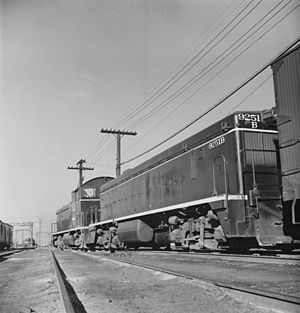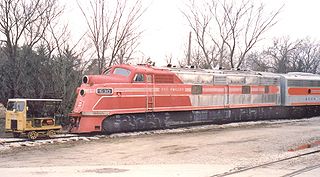
The EMD E6 was a 2,000-horsepower (1,500 kW), A1A-A1A, passenger train locomotive manufactured by Electro-Motive Corporation, and its corporate successor, General Motors Electro-Motive Division, of La Grange, Illinois. The cab version, E6A, was manufactured from November 1939 to September 1942; 91 were produced. The booster version, E6B, was manufactured from April 1940 to February 1942; 26 were produced. The 2,000-horsepower (1,500 kW) was achieved by putting two 1,000-horsepower (750 kW), 12-cylinder, model 567 engines in the engine compartment. Each engine drove its own electrical generator to power the traction motors. The E6 was the seventh model in a long line of passenger diesels of similar design known as EMD E-units.

The E9 is a 2,400-horsepower (1,790 kW), A1A-A1A passenger train-hauling diesel locomotive built by General Motors' Electro-Motive Division of La Grange, Illinois, between April 1954 and January 1964. 100 cab-equipped A units were produced and 44 cabless booster B units, all for service in the United States. The E9 was the tenth and last model of EMD E-unit and differed from the earlier E8 as built only by the newer engines and a different, flusher-fitting mounting for the headlight glass, the latter being the only visible difference. Since some E8s were fitted with this, it is not a reliable way to distinguish the two.

The EMC E2 was an American passenger-train diesel locomotive which as a single unit developed 1,800 horsepower (1,300 kW), from two (2) 900 horsepower (670 kW) prime movers. These locomotives were typically operated as a unit set or ; where the three unit lashup developed 5400 horsepower. This was almost the ideal horsepower required for the tonnage of a 15 - 18 car passenger train, operated over the ruling grades of virtually all of the mileage between major American cities. The units were of the A1A-A1A wheel arrangement, and manufactured by Electro-Motive Corporation (EMC), later Electro-Motive Diesel (EMD) of La Grange, Illinois.
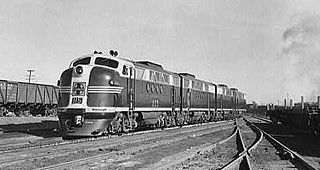
The EMD FT is a 1,350-horsepower (1,010 kW) diesel-electric locomotive that was produced between March 1939 and November 1945, by General Motors' Electro-Motive Corporation (EMC), later known as GM Electro-Motive Division (EMD). The "F" stood for Fourteen Hundred (1400) horsepower and the "T" for Twin, as it came standard in a two-unit set. The design was developed from the TA model built for the C,RI&P in 1937, and was similar in cylinder count, axle count, length and layout. All told 555 cab-equipped ”A” units were built, along with 541 cabless booster or ”B” units, for a grand total of 1,096 units. The locomotives were all sold to customers in the United States. It was the first model in EMD's very successful F-unit series of cab unit freight diesels, and was the locomotive that convinced many U.S. railroads that the diesel-electric freight locomotive was the future. Many rail historians consider the FT one of the most important locomotive models of all time.

The EMD F2 was a freight-hauling diesel locomotive built by General Motors Electro-Motive Division between July 1946 and November 1946. It succeeded the FT model in GM-EMD's F-unit sequence, and was replaced in turn by the F3. The F2 was in many respects a transitional type between those two; it kept the 1,350 hp (1,010 kW) rated D8 generator from the FT due to late development of the new D12 generator intended for the F3, but in a revised carbody design and internal layout that would be continued through the rest of the F-unit series. 74 cab-equipped lead A units and 30 cabless booster B units were produced.

EMD F-units were a line of diesel-electric locomotives produced between November 1939 and November 1960 by General Motors Electro-Motive Division and General Motors-Diesel Division. Final assembly for all F-units was at the GM-EMD plant at La Grange, Illinois, and the GMDD plant in London, Ontario, Canada. They were sold to railroads throughout the United States, Canada, Mexico and a few were exported to Saudi Arabia. The term F-unit refers to the model numbers given to each successive type, all of which began with the letter F. The "F" originally meant Fourteen, as in 1,400 horsepower (1,000 kW), not F as in Freight. Longer EMD E-units for passenger service had twin 900-horsepower (670 kW) diesel engines. The "E" meant Eighteen as in 1,800 horsepower (1,300 kW). Similarly, for early model EMD switchers, "S" meant Six hundred and "N" meant Nine hundred horsepower.
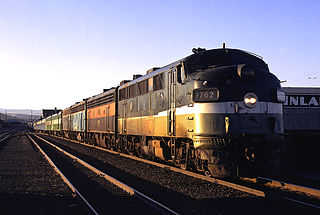
The EMD F3 is a 1,500-horsepower (1,100 kW) B-B freight- and passenger-hauling carbody diesel locomotive produced between July 1945 and February 1949 by General Motors’ Electro-Motive Division. Final assembly was at GM-EMD's La Grange, Illinois plant. A total of 1,111 cab-equipped lead A units and 696 cabless booster B units were built.

The EMD F9 is a 1,750 horsepower (1,300 kW) Diesel-electric locomotive produced between February 1953 and May 1960 by the Electro-Motive Division of General Motors (EMD) and General Motors Diesel (GMD). It succeeded the F7 model in GM-EMD's F-unit sequence. Final assembly was at GM-EMD's La Grange, Illinois plant. The F9 was also built in Canada by General Motors Diesel at their London, Ontario plant. A total of 101 cab-equipped lead A units and 156 cabless booster B units were built. The F9 was the fifth model in GM-EMD's highly successful "F" series of cab unit diesel locomotives.

The EMD FP7 is a 1,500 horsepower (1,100 kW), B-B dual-service passenger and freight-hauling diesel locomotive produced between June 1949 and December 1953 by General Motors' Electro-Motive Division and General Motors Diesel. Final assembly was at GM-EMD's La Grange, Illinois plant, excepting locomotives destined for Canada, in which case final assembly was at GMD's plant in London, Ontario. The FP7 was essentially EMD's F7A locomotive extended by four feet to give greater water capacity for the steam generator for heating passenger trains.

The EMD FP9 is an American 1,750 horsepower (1,300 kW), B-B dual-service passenger and freight-hauling diesel locomotive that was produced between February 1954 and December 1959 by General Motors Electro-Motive Division, and General Motors Diesel. Final assembly was at GM-EMD's La Grange, Illinois plant, except for Canadian orders, which were assembled by Canadian subsidiary GMD at London, Ontario. The FP9 was essentially EMD's F9 locomotive extended by four feet to give greater steam generator and water capacity for hauling passenger trains. A total of 90 cab-equipped lead A units were built; unlike the freight series, no cabless booster B units were sold. Regular F9B units were sometimes used with FP9 A units, since they, lacking cabs, had more room for water and steam generators. The FP9 and its predecessor, the FP7, were offshoots of GM-EMD's highly successful F-unit series of cab unit diesel locomotives.

The EMD NW2 is a 1,000 hp (750 kW), B-B switcher locomotive manufactured by General Motors Electro-Motive Division of La Grange, Illinois. The NW2 was manufactured from February 1939 to December 1949, and 1145 were produced – 1121 for the U.S., and 24 were exported to Canada. Starting in late 1948 the NW2s were manufactured in EMD's Plant #3 in Cleveland, Ohio. The 1,000 hp (750 kW) was achieved by using a 12-cylinder, model 567, and later, a model 567A engine. In addition, 3 TR cow-calf paired sets, 36 TR2 cow-calf paired sets, and 2 TR3 cow-calf-calf sets were produced. The TR sets were built prior to World War II and the TR2 and TR3 sets were built postwar.

An EMD SW9 is a diesel switcher locomotive built by General Motors Electro-Motive Division between November 1950 and December 1953. Additional SW9s were built by General Motors Diesel in Ontario Canada from December 1950 to March 1953. Power was provided by an EMD 567B 12-cylinder engine, producing 1,200 horsepower (895 kW). Starting in October 1953 a number of SW9s were built with the 567BC engine and in December 1953 Weyerhaeuser 305 was built with a 567C engine.

An EMD SW900 is a diesel switcher locomotive built by General Motors Electro-Motive Division and General Motors Diesel (GMD) between December 1953 and March 1969. Power was provided by an EMD 567C 8-cylinder engine that generated 900 horsepower (670 kW). Built concurrently with the SW1200, the eight-cylinder units had a single exhaust stack. The last two SW900s built by GMD for British Columbia Hydro were built with 8 cylinder 645E engines rated at 1,000 horsepower (750 kW).

An EMD SW1200 is a diesel switcher locomotive built by General Motors Electro-Motive Division between January 1954 and May 1966. Power is provided by an EMD 567C 12-cylinder engine which generates 1,200 horsepower (890 kW). Late SW1200s built in 1966 were built with the 567E 12-cylinder engine. Additional SW1200 production was completed by General Motors Diesel in Ontario, Canada, between September 1955 and June 1964.

The EMD GP7 is a four-axle (B-B) road switcher diesel-electric locomotive built by General Motors Electro-Motive Division and General Motors Diesel between October 1949 and May 1954.

The EMD GP15-1 is a 4-axle switcher diesel-electric locomotive built by General Motors Electro-Motive Division between June 1976 and March 1982. Intended to provide an alternative to the rebuilding programs that many railroads were applying to their early road switchers, it is generally employed as a yard switcher or light road switcher. This locomotive is powered by a 12-cylinder EMD 645E engine, which generates 1,500 hp (1,119 kW). The GP15-1 uses a 50-foot-9-inch (15.47 m) frame, has a wheelbase of 29 ft 9 in (9.07 m) and has a length over couplers of 54 ft 11 in (16.74 m). A total of 310 units were built for American railroads. A number of GP15-1s remain in service today for yard work and light road duty. The radiator section is similar to those found on the EMD SD40T-2 and EMD SD45T-2 "tunnel motors," leading some observers to incorrectly identify the units as such or as GP15Ts, and giving them the nickname "baby tunnel motors".
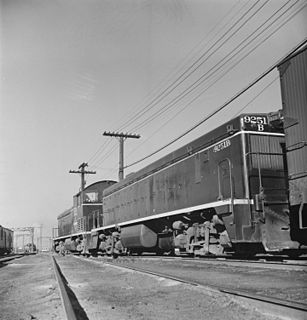
In North American railroading, a cow-calf locomotive is a set of switcher-type diesel locomotives. The set usually is a pair; some 3-unit sets were built, but this was rare. A cow is equipped with a driving cab; a calf is not. The two are coupled together and are connected with MU cables and brake lines so that both locomotive units can be operated from the single cab.
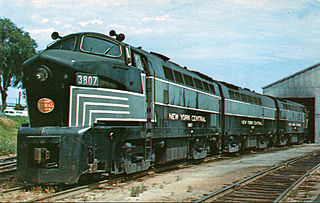
The Baldwin RF-16 was a 1,600-horsepower (1,200 kW) cab unit-type diesel locomotive built for freight service by the Baldwin Locomotive Works between 1950 and 1953. All RF-16s were configured with a B-B wheel arrangement and ran on two AAR Type B two-axle road trucks, with all axles powered. A total of 109 cab-equipped A units were built, along with 51 cabless booster B units, for a total of 160 locomotives built. As was the case with most passenger locomotives of its day, the RF-16s came equipped with a retractable, nose-mounted drop coupler pilot. Unlike competing units from EMD and Alco, the RF-16 used an air-powered throttle, meaning that it could not be run in MU operation with EMD or Alco diesels without special MU equipment.

A B unit, in railroad terminology, is a locomotive unit which does not have a control cab or crew compartment, and must therefore be operated in tandem with another coupled locomotive with a cab. The terms booster unit and cabless are also used. The concept is largely confined to North America. Elsewhere, locomotives without driving cabs are rare.
